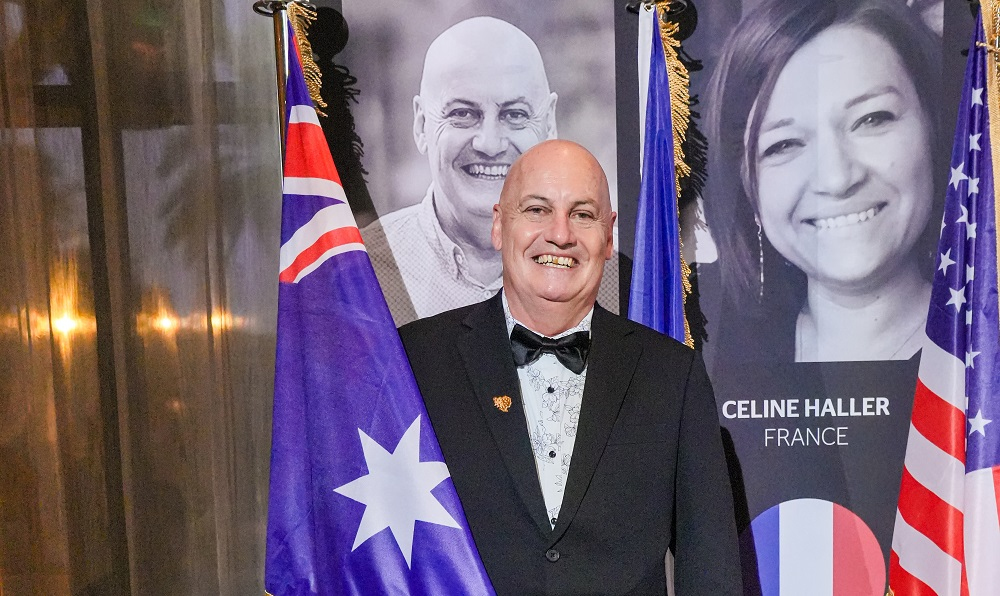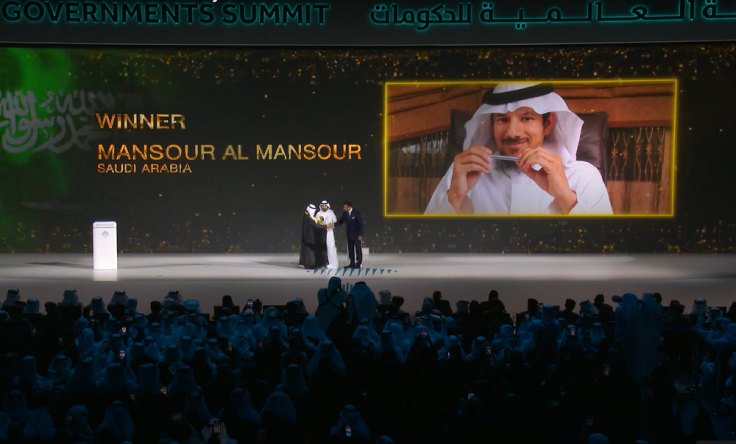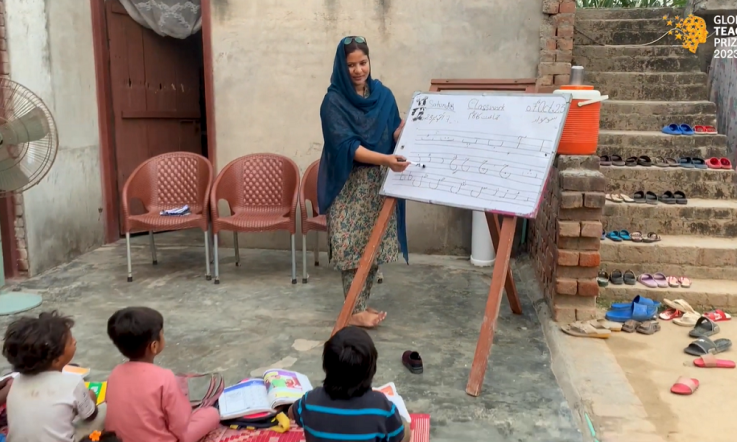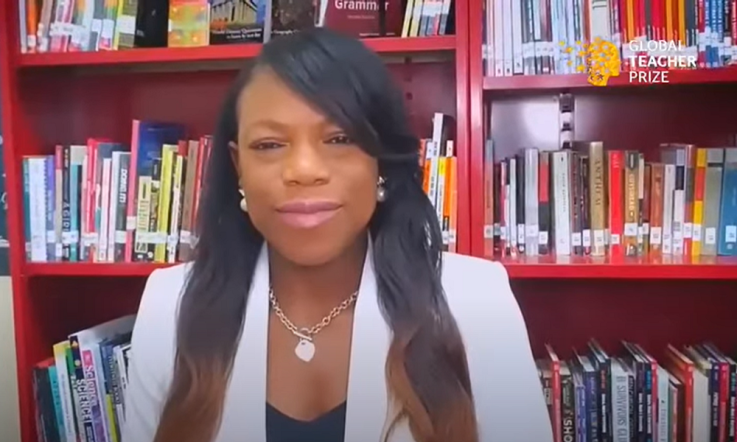This podcast from Teacher is supported by Sora, the student reading platform that provides access to curriculum and popular digital books for schools. Learn more at discoverSora.com/global
Hello and thanks for listening to this very special episode from Teacher magazine, I’m Rebecca Vukovic.
The winner of the 2025 Global Teacher Prize has been announced. Mansour Al Mansour from Saudi Arabia has walked away with the $1 million US dollars in prize money. Mansour was recognised for his strategic vision and unwavering belief in his students' potential, and for building an inclusive and innovative learning environment.
One Australian teacher was a top 10 finalist this year – our very own Brett Dascombe from Wavell State High School in Brisbane. Brett is a Senior Geography Teacher doing some incredible work in his school. He introduces his students to real-world, project-based learning, by embedding geospatial technologies like GIS, drones and remote sensing data into the geography curriculum. He’s also really keen to share his expertise with the wider community, by participating in professional learning and training with other schools. He is very clearly having a massive impact on his community, and now his work has been recognised on the world stage. I sat down with Brett ahead of the announcement to hear all about this work, and after 23 years in the profession, what it means to him to be recognised in the top 10 this year.
Rebecca Vukovic: Brett Dascombe, thanks for joining Teacher magazine.
Brett Dascombe: Thank you. Thanks for the invite.
RV: Congratulations on being named in the top 10 finalists for the Global Teacher Prize this year. You must be thrilled. What does this recognition mean to you?
BD: It's pretty overwhelming, actually. I got really emotional when they called me and told me I was top 10. I didn't think I'd be like that, but… Having taught for 20 years, it's just amazing recognition to, you know, all the work that goes into being a teacher. My partner would tell you that I work too many hours after school, like most teachers.
And yeah, it's just wonderful recognition, just to see the quality of teachers that are in the top 10, and even – look top 50, I would have been stoked; when you look at what are the other teachers are doing, it's just simply amazing. Some of the work they're doing in Colombia, and in Malawi, in Saudi Arabia. I was filming myself for the awards ceremony and I had my little drone following me, and I'm walking around our beautiful high school, and I'm just thinking how lucky I am to be a teacher and be a teacher here at Wavell.
RV: It is fantastic recognition, and I do want to hear a little bit more about Wavell because you're a Senior Geography teacher at Wavell State High School in Brisbane. I'd love to hear a little bit more about your school and its context.
BD: Yeah, we're a public school, a public education school, about 1,600 to 1,800 students yearly. We are in the northern suburbs of Brisbane. We pull from a really wide catchment, really diverse multicultural cohort and that's been a bit of an interest of mine recently and we've got some amazing students. One of the students in my year 12 geography class has started a Pasifika empowerment group and she invites me along and it's just wonderful to be involved in sort of understanding different cultures and seeing them lead – the student agency at this school is next level and that's come about with the change of administration and our executive principal over the last 4 years. With this growth mindset and student agency, it's just changed the dynamic of our school. It's such a wonderful place to work these days.
RV: Yeah, it sounds like a beautiful community. Brett, why did you decide to become a teacher in the first place? Was there a particular teacher that inspired you?
BD: It is such a typical story; it is such a typical story. Yeah, Gordon Rackley. He was my HPE health teacher in Kingaroy State High School and he was a really inspiring, young teacher at the time. My mother also was a teachers’ aide, and she never got a formal university degree, but just worked with a wide range of students out at Kingaroy. And she was inspiring to me as well. I came to education in a little bit of a different way. I joke with my students that I had an 18-year gap year between year 10 and university. So I came back, I was a professional vagabond, travelled the world for a number of years and then came back to education and loved it. And I've been a teacher ever since, I think about 23 years now.
RV: And so, I want to hear a little bit more about the work you've been doing at your school now, because much of it is the reason you were in the top 10 for the Global Teacher Prize in the first place. Can you tell me a little bit about the ways that you embed geospatial technologies like GIS, drones and remote sensing data into the geography curriculum at your school?
BD: Yeah, it's been a bit of a journey. Like I did, one unit of remote sensing and one of GIS when I was at university and fell in love with it, and I've always used it in my classroom. But over the last 5 years, I helped write the new geography syllabus here in Queensland and then Esri released a free software version of a GIS package. I played around with it and had a look, and my students were really engaged with it when we're playing around with it. And it led to me speaking to QCAA [Queensland Curriculum and Assessment Authority], the wonderful Julie Davis at QCAA, and I said, ‘can I submit a like a web address as an assessment piece for my seniors?’ And it was a definite ‘no’, but we sort of negotiated around and I now record their interactive assessment pieces and send it in as an MP4.
And they can do swipe maps, and we can use drone footage from fieldwork. We can use 3D mesh or digital twins – it's more 3D mesh – and you see the students’ personality. We've actually recorded 360-degree camera footage at an intersection. We've put that into YouTube, and you can look at it from all different angles in a 360. So just really interesting technology that’s used an industry but then bringing it back. The drone I'm using at the moment cost $300 and is 135 grams – so technology has improved so much in the last 5 years and our students are so …
I get them to unbox any new technology and, basically, they set it up for me in 10 minutes where I'd be struggling with it for an hour. So, they're the experts in my classroom, and it's wonderful to see. You see their personalities in their work. They can do a swipe map of like a before and after… really interactive, they can make the map move around, they can put their own backgrounds on. Lots of interactive nature and you just see that they engage with the technology. It's just a great technology and could be used across many subjects, not just geography. We're having a drone lesson in week 4, and then we'll do some drone work outside, and it's great to see them just, they take to it like it's second nature.
RV: Yeah, and Brett you've listed off some of the things that the students have been doing in the class but I'm wondering, do you have any examples of students using this geospatial technology out in the community? Because I'm wondering how and what this teaches them about real-world learning.
BD: My favourite example and we're going back, I think week 6, we go back over to Stradbroke Island. So, we go to Minjerribah, have a look at Cylinder Beach. And what we've discovered is at the back of Cylinder Beach, there's E. coli at levels probably 400 times the amount that should be there. Now in 2017, it was the second most popular beach in Queensland. So, we traced where the E. coli was coming from (or we think we have), and we've written reports and they've gone away, and we talked to the Friends of Stradbroke Island community. They engage with the president – I've got him talking to the students in a couple of weeks – and it really is that sense of a real-world project. They're discovering real-world issues.
Our local waterway, recently the students were flying a drone over it. We did some testing, and we found they’re starting to see some PFAS [per- and poly-fluoroalkyl substances] levels. So, you know, PFAS is a long-life carcinogen in the water. So, real-world projects are really, really important to me like, yeah, real-world projects are where it's at. I'm currently getting my students, while I'm away, to talk to their local primary school and put in a grant application for the local school on a global competence project. So, it might be a community garden or a First Nations garden. Or it might be to get some technology for the school to do multicultural events.
So real-world projects and contributing to our community is really important to me, and you can do that through geography projects, that's for sure.
RV: Yeah. And I can imagine that the students just love being involved in these project-based, real-world learning activities. I'm wondering a little bit about their engagement, because I'm assuming that this has a really big impact on their engagement, and their overall performance in assessments as well.
BD: Yeah, definitely with our seniors, they perform above state levels in some of the higher … particular communication and analysis, that's where I see the increase. The engagement definitely for my class. And last year I had a little bit of time to mentor other teachers, and they start to see the engagement of the students in their classrooms. Working together collaboratively – all these 21st century soft skills that you talk about, these guys are really good at it, but they just need the opportunity to engage in that. They'll find their own crew in the room; like, I set my room up with tables in 4s and 5s and not the traditional lines, because they work really well collaboratively. So, it's really wonderful to see their engagement.
Behaviour problems aren't really a reality in my classroom, although I'm not a believer of the ‘don't smile until Easter philosophy’, mine's like, they're already talking about me, so I started up by saying, ‘look, no homework and no high stakes exams in my first term’. And that just, ‘oh, OK’, the change-up. So, I'm always looking to change my classroom practice as well and improve my classroom practice. I read over the holidays, I was reading some Ron Ritchhart and some Yong Zhao, and I'm now getting them to call me ‘Brett’. First time I've ever done that, and they think it's hilarious. They're having a great time with it. But you know, I call them by their first name. So why? And it just creates that connection to the students as well.
RV: Why not give it a go and see how and see how it works. Have the students been enjoying calling you Brett?
BD: Umm, they’re struggling with it a little bit. Some, some not so much. Some think it's a great laugh, particularly the boys. Like it's like, ‘Oh Brett’…
RV: I think I still struggle to call my teachers by their first names if I see them out at the shops, for example. I still revert back to Mr and Mrs… it’s ingrained in us.
BD: Yeah, a lot of my ex-students are like that as well. And I always try and reinforce, no, it's Brett. It's Brett now, like my dad is Mr Dascombe.
Coming up, we hear how Brett is using interactive assessments in his classes, and I ask him what he plans to do with the $1 million prize money if he wins. But first, here’s a quick message from our sponsor.
You’re listening to a podcast from Teacher magazine, supported by Sora, the student reading platform that provides every student with access to the right books. Sora offers your school’s curriculum titles, along with popular leisure titles available digitally anytime, anywhere. Visit discoversora.com/global today to learn why Sora is a worldwide leader for digital ebooks and audiobooks for students.
RV: Brett, speaking of assessments, I've read that you advocated for interactive assessments. For example, you successfully collaborated with the Queensland Curriculum and Assessment Authority to introduce modern geospatial tools into the senior geography assessments. Can you tell me a little bit more about that?
BD: Yeah, it sort of happened by mistake. I fell across a really good application called Story Maps. We did some really good work in it, and I discovered you could put lots of interactive videos in there, interactive graphs. And I talked to Julie Davis at the QCAA and said, ‘look, can we, can we trial something? Can we put something in?’ And she was really supportive of that, and I see a lot of teachers now across Queensland doing the same sort of technology. And it's really rewarding to see other teachers, and sometimes they'll send me their work to moderate; and to see the quality of the work that's coming out.
It was funny, I was up at the Fraser Coast, working with some schools and the teacher from Maryborough showed me a Story Map that is [from] one of his students. I went, ‘whoa’, he said, ‘oh yeah, we haven't even … she's gone and sourced that herself, she saw one of the videos you've done, she went and sourced that and she's created…’ – that's a 25 out of 25. I looked at it and went, ‘that's so good’. And he's like ‘yeah, look, it's got interactivity, they can zoom into a field work site, they can put in Google Earth 3D imagery’. It's just the next way we're going to improve education because like we talked about, it engages the students in real-world activities.
I've had a couple students say to me it's the most proud they've ever been of an assessment piece when they've completed it and that's just so rewarding for me to know that, you know, I'm doing something a little bit different and a little bit engaging for students. It’s not the traditional, you know, 50-page report on paper – and we’re paperless here for those assignments as well, so that's a really good thing as well.
RV: Yeah, fantastic. Brett, it's clear that it's not just your school community of Wavell State [High] School benefiting from your expertise, you also participate in professional learning and training with other schools, as well as partnerships in the wider community. Why is this important to you?
BD: It's really important because I just see the young teachers coming through and the skillsets they bring to teaching, but they don't have the confidence sometimes to use it in the classroom. And just to be able to… I've got such a strong skillset in building projects, that I can talk to a school and what they want to do and then build 4 or 5 projects that I can just take and give to them. And they can get on that road.
It's funny, the teacher I mentioned at the start, he was at Grace Lutheran College and one of my ex-students who went into urban planning now works there; and he's got a mad set of skills and I'm just nominating him as an emerging Geospatial Technologies Award teacher. And it's really important to give back. I've been teaching for 23 years, 24 years, I think it’s really important that our young teachers see that there is a different way of doing things in the classroom and it's not wrong, it's not right, it's just what fits with your teaching style and what you do.
I've got a YouTube channel, I've only got, the kids think it's hilarious, I've got 317 subscribers. They're like, ‘is that all?’ They're so hip with it. It's really funny. But yeah, those YouTube videos, a teacher or a student can go to them, and I've had a lot of teachers give me feedback that, ‘look, that's helped me understand it, my students get it, and they can do it without me’. And you know, it's just giving back to the community, the education community. When I started teaching, it was like ‘that resource is mine and no one, no one's ever going to use it’. And I'm 60 and I've got probably 5-7 years to get as much of this sort of out there and grow the use of spatial technologies. I mean, they’re in our pockets, for goodness sake, we use them every day of our life. It's so important to understand how technology can be used effectively.
RV: Yeah. Fantastic. And finally, Brett, we're speaking ahead of the announcement next week. Let's imagine for a moment that you win the big prize. How do you plan on spending the $1 million prize money?
BD: Yeah, I don't, I don't imagine I will win it. There are so many amazing teachers in that top 10 and what they do and working in some really challenging situations. But they ask you to submit how you would spend it. So, I really, I love peer-to-peer learning and teaching, and I'd love some of their students to work with me to take some geospatial technologies to schools in the Pacific and in First Nations communities here in Australia – so that would be, that would be my major project. In fact, before I came and talk to you, I was looking at a DFAT webinar for working in the Pacific. So yeah, I'm sort of always looking for the next project and how we can do that.
My year 10s, 2 years ago, designed a project for Nauru and we almost got it over the line. I failed a little bit because I couldn't access funding, but they got it to the point where we had the lessons created to take to Nauru. Because Nauru's an amazing place, they have a 91% attendance rate in primary school, and it drops to 41 in secondary schools. So, to go over there and engage students in drone technology, mapping cultural heritage sites, you know … and the climate change/sustainability angle of that is really important as well to me, because I'm teaching geography, I've got to be all about that as well. So yeah, there's lots of projects in my head. I’m a big picture thinker, the fine details sometime escape me, but that's all right.
RV: Fantastic. Well, best of luck. Brett will be watching. We can't wait to hear. It has been so lovely chatting with you. Thank you for sharing all that with Teacher magazine.
BD: Thank you, Rebecca. Thanks for your time as well.
That’s all for this episode. Thanks for listening. Don’t forget to follow our podcast channel wherever you get your podcasts from, so you can be notified of any new episodes as soon as they land. It also helps more people like you to find our podcast and it’s a really big help for our team.
You’ve been listening to a podcast from Teacher magazine, supported by Sora, the student reading platform that provides access to curriculum and popular digital books for schools. Learn more at discoverSora.com/global.
Do you expose students to real-world learning activities? What does this teach them about the world around them? What impact does this have on their engagement and learning outcomes?
Brett Dascombe prioritises sharing his expertise with the wider community, by presenting at conferences and other professional learning events. How could you do this in your own setting? How could you showcase your work, skills and expertise to other educators?



